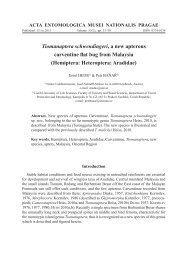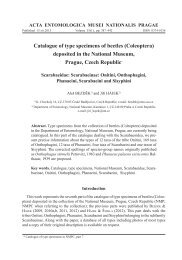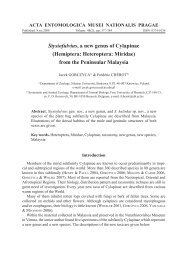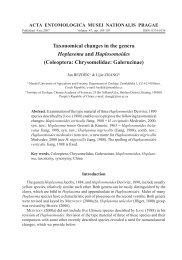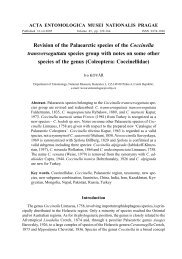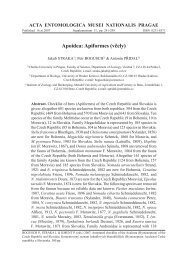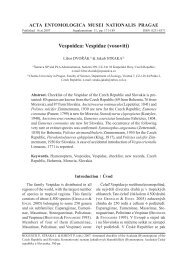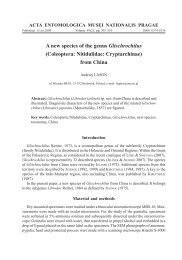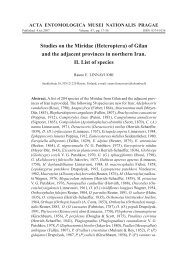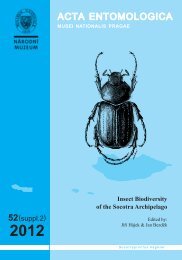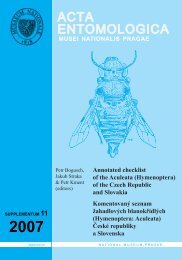(Hemiptera: Heteroptera: Miridae: Phylinae) from Morocco - Acta ...
(Hemiptera: Heteroptera: Miridae: Phylinae) from Morocco - Acta ...
(Hemiptera: Heteroptera: Miridae: Phylinae) from Morocco - Acta ...
You also want an ePaper? Increase the reach of your titles
YUMPU automatically turns print PDFs into web optimized ePapers that Google loves.
422<br />
MATOCQ: A new species of Megalocoleus <strong>from</strong> <strong>Morocco</strong><br />
12. Second segment of antenna slender, at least 1.5 mm long. Female: pubescence generally<br />
pale dense and fi ne, dark hairs sparse. Male: pubescence brownish, fl exible, not dense.<br />
Rostrum in both sexes very long, reaching or even surpassing posterior end of abdomen.<br />
Large species. ................................................................ *M. longirostris (Fieber, 1861)<br />
– Second segment of antenna much shorter, 1.1 mm long; apex of rostrum reaching middle<br />
of abdominal segment VIII. ............................................................... *M. stysi sp. nov.<br />
– Second segment of antenna shorter, 1.25 mm long. .................................................... 13<br />
13. Brown pubescence dense, hairs thick; pale pubescence sparse and fi ne. Apex of rostrum<br />
surpassing abdominal segment VIII (male) or reaching its basal quarter (female). Corium<br />
sometimes with a round, more or less pronounced mark. ..... *M. lunula (Fieber, 1861)<br />
– Brown and pale pubescence fi ne and rather dense, evenly distributed. Apex of rostrum<br />
surpassing abdominal segment VIII (male) or reaching its middle (female). Cuneus<br />
sometimes orange. ................................................................... *M. naso (Reuter, 1879)<br />
Etymology. The species is dedicated to Prof. Pavel Štys on the occasion of his 75th birthday<br />
and in recognition of his important contribution to our knowledge of the <strong>Heteroptera</strong>.<br />
Distribution. Northwestern <strong>Morocco</strong>.<br />
Discussion<br />
Specimens of Megalocoleus are commonly mixed in collections with specimens belonging<br />
to other similar genera, in particular with Amblytylus Fieber, 1858 (and vice versa). I have<br />
already mentioned the diffi culties of separating these two and other genera such as Tinicephalus<br />
Fieber, 1858 (MATOCQ 2004), which are due to the insuffi cient defi nition of generic<br />
characters. Megalocoleus stysi sp. nov. exhibits all the external characters previously listed<br />
for the genus in a provisional diagnosis (MATOCQ 2004: 71): the general colouration, shape<br />
of the head, comparative length of the tarsal segments, and morphology of the claws. Only<br />
one character (lateral margin of the pronotum slightly carinate) does not fi t well with the<br />
defi nition of the genus. However, the most important diagnostic character is the form of the<br />
vesica (Figs. 6 and 7).<br />
Acknowledgments<br />
I am very grateful to P. Schwendinger, C. Lienhard and J. Hollier (all MHNG) for the loan<br />
of mirid specimens and kind support during my different stays at MHNG. I would also like<br />
to thank J. Hollier for checking the English text, G. Hodebert (Paris) for the drawing of Fig.<br />
1, and F. V. Konstantinov (St. Petersburg, Russia) and S. Pagola-Carte (Donostia, Spain) for<br />
valuable comments on the manuscript.<br />
References<br />
KERZHNER I. M. & JOSIFOV M. 1999: <strong>Miridae</strong> Hahn, 1933. Pp. 1-577. In: AUKEMA B. & RIEGER Ch. (eds):<br />
Catalogue of the <strong>Heteroptera</strong> of the Palaearctic Region. Volume 3. Cimicomorpha II. The Netherlands Entomological<br />
Society, Amsterdam, xiv + 577 pp.<br />
MATOCQ A. 2004: Revue des espèces attribuées au genre Megalocoleus Reuter, 1890 (<strong>Heteroptera</strong>: <strong>Miridae</strong>). Annales<br />
de la Société Entomologique de France (N. S.) 40: 69-101.<br />
SCHUH R. T. 1995: Plant bugs of the world (Insecta: <strong>Heteroptera</strong>: <strong>Miridae</strong>): Systematic catalog, distributions, host<br />
list, and bibliography. The New York Entomological Society, New York, xii + 1329 pp.



